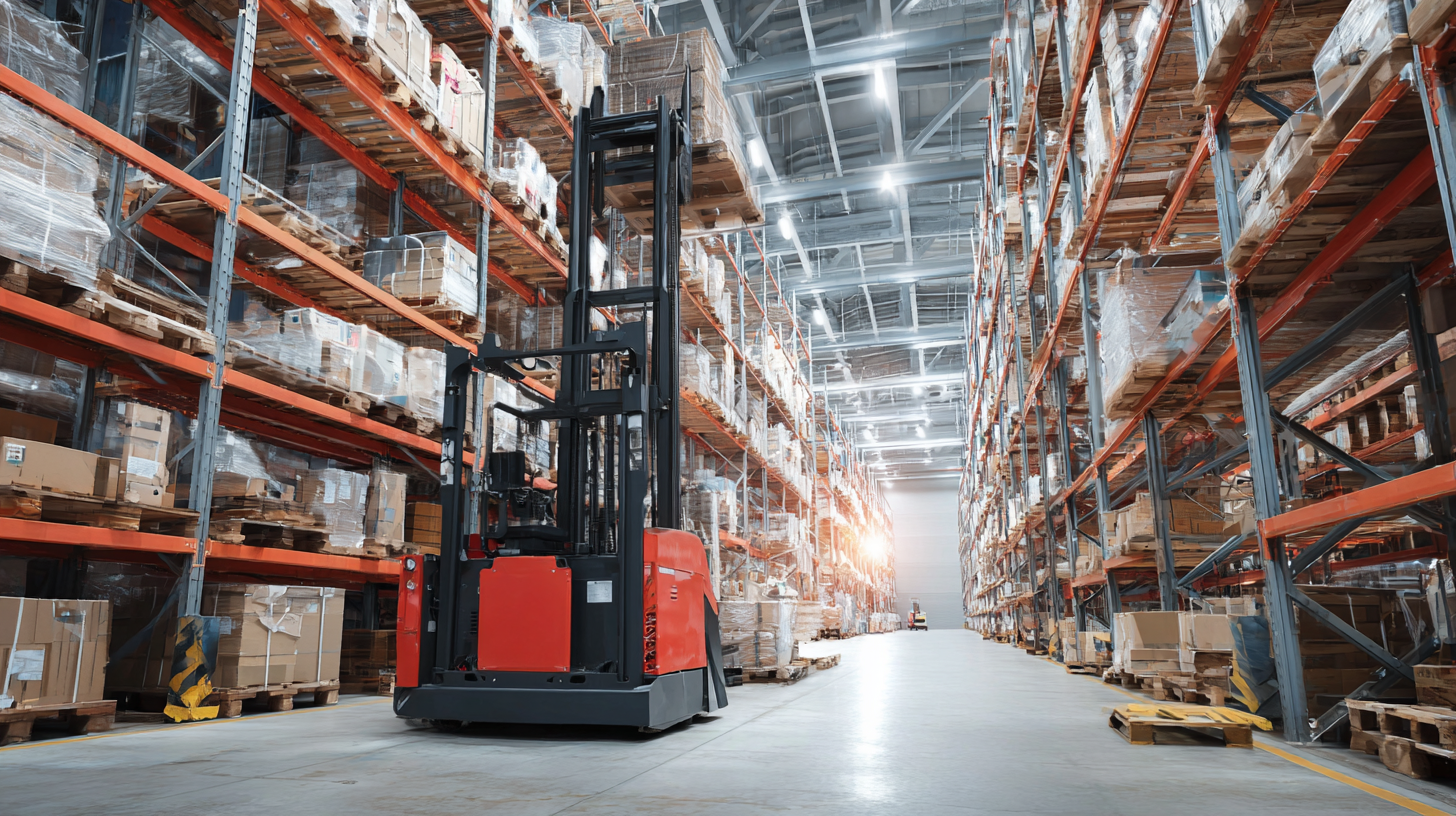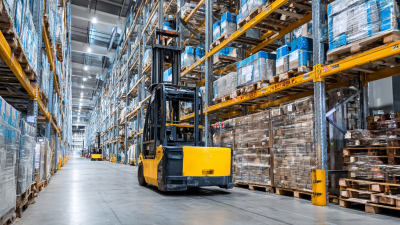Revolutionizing Warehousing: How Advanced Material Handling Equipment Boosts Efficiency by 30% in Supply Chains
The logistics and supply chain industry is in the midst of a transformative era, driven by the need for heightened efficiency and responsiveness to market demands. According to a 2022 report by the Material Handling Industry of America (MHIA), the integration of advanced Material Handling Equipment (MHE) into warehousing operations can enhance productivity by as much as 30%. This substantial improvement is attributed to the automation of routine tasks, minimization of manual errors, and optimized workflow processes.

As businesses increasingly seek to streamline operations and reduce costs, MHE has emerged as a critical component in achieving these objectives. By embracing innovative technologies such as robotics, conveyor systems, and automated storage solutions, organizations can not only meet current supply chain challenges but also position themselves for future growth and competitiveness in an evolving marketplace.
The Role of Automation in Modern Warehousing Efficiency Enhancements
Automation is transforming modern warehousing efficiency at an unprecedented rate. According to a report by McKinsey, the introduction of advanced material handling equipment (MHE) can increase operational efficiency by up to 30%. Automated systems like robotic picking, conveyor belts, and smart inventory management software streamline processes, reducing human error and operational delays. With the growing complexity of supply chains, implementing automation not only speeds up order fulfillment but also cuts labor costs significantly.
Tips for enhancing automation in your warehouse: consider starting with a pilot program that tests robotic solutions in a limited area before scaling up. This allows you to evaluate performance metrics and identify any potential challenges without fully committing resources. Additionally, ensure that your staff is adequately trained on new technologies to optimize integration and maintain productivity levels.
Investing in automation also supports real-time data analytics, giving businesses better oversight of inventory levels and demand forecasting. A study from the Warehousing Education and Research Council highlighted that warehouses utilizing data-driven automation saw a 25% reduction in excess inventory. By embracing these technologies, companies can not only optimize their processes but also enhance overall supply chain resilience.

Comparative Analysis of Traditional vs. Advanced Material Handling Equipment
Traditional material handling equipment, such as manual pallet jacks and forklifts, have long been the backbone of warehouse operations. However, their limitations in efficiency, accuracy, and labor intensity have prompted a shift towards advanced material handling technologies. According to the Material Handling Industry of America (MHIA), implementing advanced solutions can enhance operational efficiency by as much as 30%. Automation tools like Automated Guided Vehicles (AGVs) and robotic pickers streamline processes, reduce error rates, and allow for a more flexible workforce.

When comparing traditional vs. advanced equipment, it becomes apparent that the initial investment in advanced technologies often pays off in the long run. A report from the Warehouse Efficiency Index indicates that automated systems can lead to a 15% reduction in labor costs while increasing throughput by 40%. These improvements not only boost productivity but also enhance safety by reducing the risk of workplace accidents associated with manual handling tasks.
Tips: To maximize the benefits of advanced equipment, consider conducting a thorough analysis of your warehouse layout to identify integration points for automation. Additionally, investing in training for your workforce on new technologies is crucial to ensure a smooth transition and improved operational efficiency. Regularly monitoring performance metrics will help identify areas for further optimization.
Impact of Real-Time Data Tracking on Supply Chain Optimization
In today’s fast-paced supply chain environment, real-time data tracking has emerged as a pivotal component in optimizing operations. By leveraging advanced technologies such as IoT sensors and cloud computing, warehouses can monitor inventory levels, equipment efficiency, and shipment statuses instantaneously. This immediate access to critical data not only reduces delays but also significantly enhances decision-making processes, giving businesses a competitive edge.
Tip: Implementing automated data analytics tools can streamline the process of interpreting real-time data, allowing teams to focus on strategic improvements rather than being bogged down by manual tracking.
Moreover, real-time visibility allows for proactive management of potential disruptions. When unexpected events occur, such as equipment failures or supply shortages, having up-to-the-minute information enables managers to respond quickly, minimizing downtime and maintaining productivity. Organizations that capitalize on this capability can increase their operational efficiency by up to 30%.
Tip: Regular training sessions for staff on new data tracking technologies can ensure that everyone is equipped to utilize these tools effectively, leading to a more responsive and agile warehouse environment.
Case Studies: Companies Achieving 30% Efficiency Increases with New Technologies
The implementation of advanced material handling equipment has transformed the logistics landscape, as evidenced by several case studies demonstrating a remarkable 30% increase in efficiency for various companies. For instance, a leading e-commerce giant adopted automated guided vehicles (AGVs) in their warehousing operations. This technology drastically reduced the time required for inventory retrieval and order fulfillment, leading to faster shipping and improved customer satisfaction. As a result, the company's overall throughput increased, allowing them to handle a larger volume of orders without compromising quality.
Another notable case is a manufacturing firm that integrated robotic picking systems to replace manual labor. By employing artificial intelligence and machine learning algorithms, the robots could quickly identify and sort products, minimizing errors and enhancing accuracy in order picking. This not only streamlined their operations but also reduced labor costs, contributing to a substantial boost in productivity. These case studies illustrate how technological advancements in material handling can drive significant efficiency gains across various sectors within the supply chain.
Revolutionizing Warehousing: Efficiency Increase in Supply Chains
This chart illustrates the percentage increase in operational efficiency achieved by various companies after implementing advanced material handling equipment. The data reflects significant improvements ranging from 20% to 35% across different sectors, confirming the transformative impact of technology in supply chains.
Future Trends in Material Handling Equipment and Their Potential Effects on Supply Chains
The future of material handling equipment is set to transform supply chains significantly, with advanced technologies driving efficiency gains of up to 30% in various operations. As the global heavy truck market is projected to reach a value of $300 billion in 2024 and grow to $460 billion by 2033, with a compound annual growth rate (CAGR) of 4.9%, the demand for innovative material handling solutions is becoming increasingly prominent. This growth does not only pertain to trucks, but extends to various sectors, such as the marine cargo market, which is expected to rise from $156.4 billion in 2025 to $219.3 billion by 2033, reflecting a CAGR of 4.3%.
Recent trends indicate a surge in the adoption of automated equipment, like stackers, to enhance operational efficiency across diverse applications, from ports to logistics hubs. The market insights suggest a strong demand for equipment categorized by load capacities, such as under 30 tons and 30-40 tons, catering specifically to the logistics and transportation sectors. As businesses aim for higher throughput and reduced operational costs, investing in advanced material handling equipment will not only optimize workflow but also pave the way for a more resilient supply chain. With these positive trends, the industry is poised for substantial advancements in the coming decade.
Revolutionizing Warehousing: How Advanced Material Handling Equipment Boosts Efficiency by 30% in Supply Chains
| Equipment Type | Efficiency Increase (%) | Cost Reduction (%) | Adoption Rate (%) | Potential Future Trends |
|---|---|---|---|---|
| Automated Guided Vehicles (AGVs) | 25 | 15 | 50 | Growth in AI integration |
| Robotic Picking Systems | 30 | 20 | 40 | Enhanced dexterity and vision |
| Conveyors with Smart Sensors | 20 | 10 | 35 | Integration of IoT technologies |
| Drones for Inventory Management | 18 | 5 | 30 | Expanding applications in logistics |
| Mobile Inventory Management Systems | 22 | 12 | 45 | Real-time tracking innovations |
Related Posts
-

How to Choose the Right Material Handling Equipment for Your Business Needs
-

7 Essential Insights to Optimize Your Material Handling Efficiency and Reduce Costs
-

Exploring the Future of Material Lifting Equipment Technology Trends and Their Global Impact in 2025
-

7 Essential Tips for Choosing the Best Material Handling Equipment for Your Business
-

How to Identify the Best Manufacturers for High Quality Material Handling Supplies
-

Exploring Diverse Alternatives in Best Material Handling: Unique Features and Applications for Every Product Type

